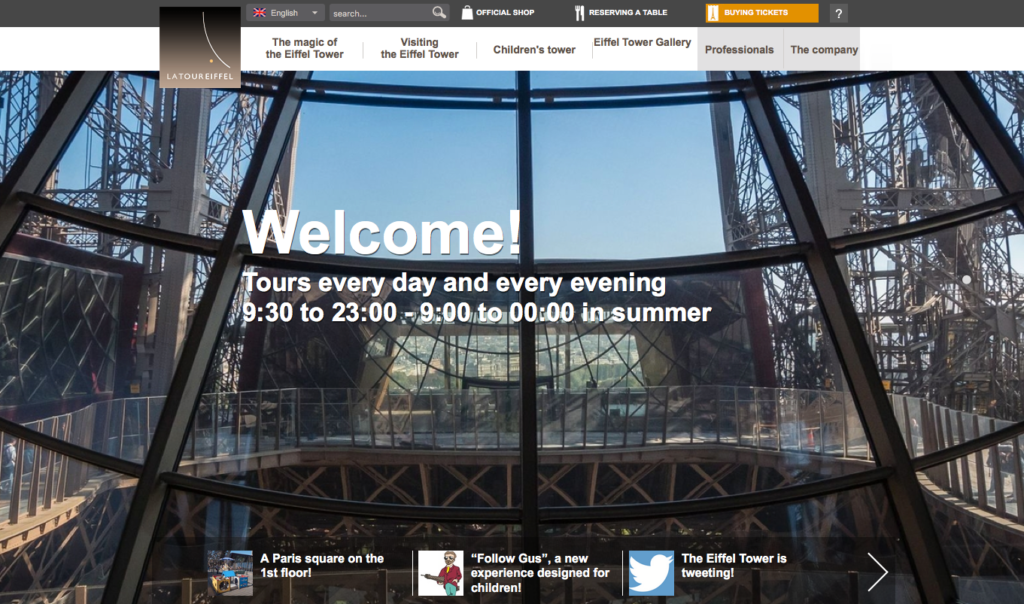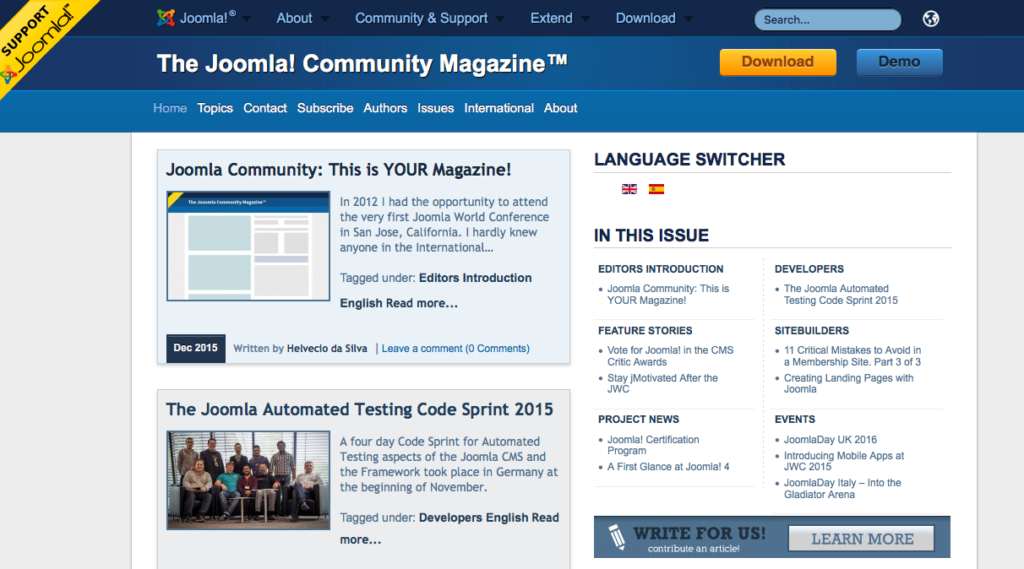As promised last week (Iron Blogger & Joomla) I’ll start to write more about Joomla! The next articles are the chapters of the book I wrote in January 2016 for the upcoming Version 3.5.
Why should I get in contact with Joomla! and what is it all about.
Joomla! is a free system for creating websites. It is an open source project, which, like most open source projects, is constantly in motion. It has been extremely successful for ten years now and is popular with millions of users worldwide. It is easy to install, easy to manage, easy to enhance and very reliable. More and more people around the globe are able to make a living by using Joomla.
History
The word Joomla! is a derivative of the word Jumla from the African language Swahili and means “all together”. The project Joomla! is the result of a heated discussion between the Mambo Foundation, which was founded in August 2005, and its then-development team. Joomla! is a development of the successful system Mambo. Today Joomla! is used all over the world to power websites of all shapes and sizes. The Joomla! team has organised and reorganised itself throughout the last 10 years to better meet the user demands.
Joomla! Version Strategy
The version strategy of Joomla! changed over the years. Today Joomla! versions numbers are spared by dots: [major].[minor].[patch]. For example, Joomla! 3.5.0 has a major number of 3, a minor number of 5 and a patch number of 0.
- Major release (3):
A release which increments the major number has a predictable end of life date of two years. After each minor version the two year phase starts again. A major release indicates a break in backward compatibility. - Minor release (5).
A release which increments minor number resets the two years lifetime of the major release and indicates the addition of new features or a significant change to existing features. - Patch release (0):
A release which increments the patch number has no influence on the end of life date and indicates that bugs have been fixed.
The complete changes in the Joomla! 3.x series can be seen at the projects website
The smart way of Joomla
The Joomla! Project is different from other projects like Drupal or WordPress. The Joomla! project is not backed a company. The only entity that serves the financial and legal interests of the Joomla! project is Open Source Matters, a not-for-profit organisation.
It is possible to build nearly every website you can imagine using Joomla! on your own with your own knowledge spending nothing but your time, but it’s possible too to download extensions like shopping carts to build your desired website in a much shorter time. The existence of this sustainable, flexible and very diverse network of service providers based on a free and open source foundation is unique and an opportunity to every person in the world to use Joomla! as a consumer and/or a producer.
Thousands of companies around the world are developing extensions for Joomla! which you can download in a kind of app store, the Joomla! Extensions Directory. There are free and paid extensions.
Additionally the use of the Joomla! extension directory is free of charge, so the Joomla! project is the base of a vibrant community of consumers and producers of smart software.
This mindset leads to an interesting community of people, involved in the project and who are working somehow together on the project. It is always possible to contribute to the project in the way you are able and willing to.
Websites made with Joomla
All kinds of dynamic websites can be created with Joomla. These websites consists of web pages containing content such as text, images, video and audio. The pages changes or customises themselves frequently and automatically, based on certain criteria. Take the front page as an example. Usually it displays the newest articles automatically on top. As all the sites in the world wide web are based on the same principles websites can be roughly divided in
Weblogs
A blog is a discussion or informational site consisting of articles (posts, blog entries). The most recent articles appears first.
This is an example from Brasil (Figure 1)

The Eiffel Tower
The Eiffel Tower is a wrought iron lattice tower on the Champ de Mars in Paris, France. It is named after the engineer Gustave Eiffel, whose company designed and built the tower. Today they are using Joomla! (Figure 2).

Brochure websites
A brochure website include information about a company and its products and services through text, photos, animations, audio/video and interactive menus and navigation (Figure 3)

Electronic commerce sites
A site offering goods and services for online sale and enabling online transactions for such sales (Figure 4).

Gallery websites
A website designed specifically for use as a Gallery, these may be an art gallery or photo gallery and of commercial or noncommercial nature (Figure 5).

Government sites
More than 3,000 government websites around the world are built with Joomla! (Figure 6).

News sites
Similar to an information site, but dedicated to dispensing news, politics, and commentary (Figure 7).

Personal websites
Websites about an individual or a small group that contains information or any content that the individual wishes to include (Figure 8).

Cars
Peugeot is a French cars brand, part of PSA Peugeot Citroën … and they are using Joomla! (Figure 9).

1,000,000,000 websites
Did you ever ask yourself for the total number of Websites? There are a lot, but nobody knows the exact answer to that question.
As you may have noticed, most of the example sites are not the big fishes in the world wide web but they fulfil the needs of their creators and their clients. This does not mean, that Joomla is only useful for smaller websites, it just means that most of the websites are made with limited resources on time and budget and for that reason people often build them with open source systems like Joomla, WordPress and Drupal. Bigger websites like Facebook, Flickr, YouTube, Google, Apple, or Microsoft are usually not using one open source content management system for their websites. These companies usually have thousands of developers that create often hundred of websites by selecting and combining all the ideas and solutions available on the market. It is usually not about the technique, it’s more about business models and ideas.
Amateurs vs. Professionals
The above listed websites are created by people that I want to divide in amateurs and professionals.
- Amateurs are trying to get around. They usually do not want to know one’s stuff, they are happy if succeeded.
- Professionals try to get to the ground of what they are doing to be able to provide solutions which can be optimised over time. They try to transfer knowledge to strengthen others and build their business around the topic.
For Joomla it doesn’t matter whether you are an amateur or a professional. Both can deal with Joomla and often amateurs become professionals over time and professionals start to get more involved to make Joomla CMS and Framework better and better. Time for the first and the last advice in this book!
“Ignore people talking about what you have to do. Focus on moving toward what you like to do instead.”
What are the common parts in all these websites?
Even if the listed example websites are all very different, they have a few things in common:
- they are displaying content (text, images, video, audio)
- they have individual designs, layouts and colours. Individual doesn’t mean perfect or tasteful or artistic. It just means “individual” :)
- visitors can interact in some ways with the site. Sometimes they have to create a user account in advance
- the common static words are available in different languages, sometimes the content too.
Joomla is the glue
All these websites are based on the ideas of their creators and the almost endless possibilities of the Joomla Content Management System. In this book, I want to cover the common parts of all these websites and some examples of paid and free services to enhance the Joomla core distribution. You’ll be able to create a quite nice looking website on your own after you have read the next chapters.
And it’s up to you, whether you do it in the amateur or in the professional way :)

Leave a Reply